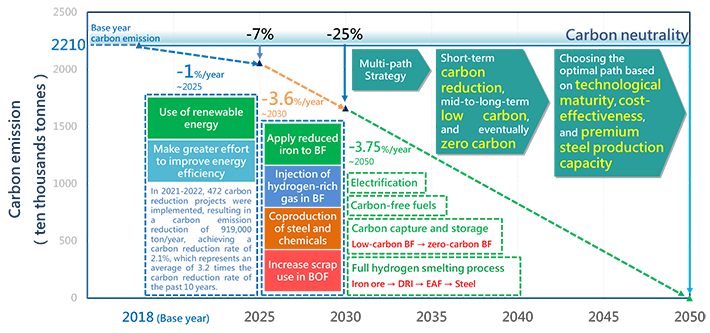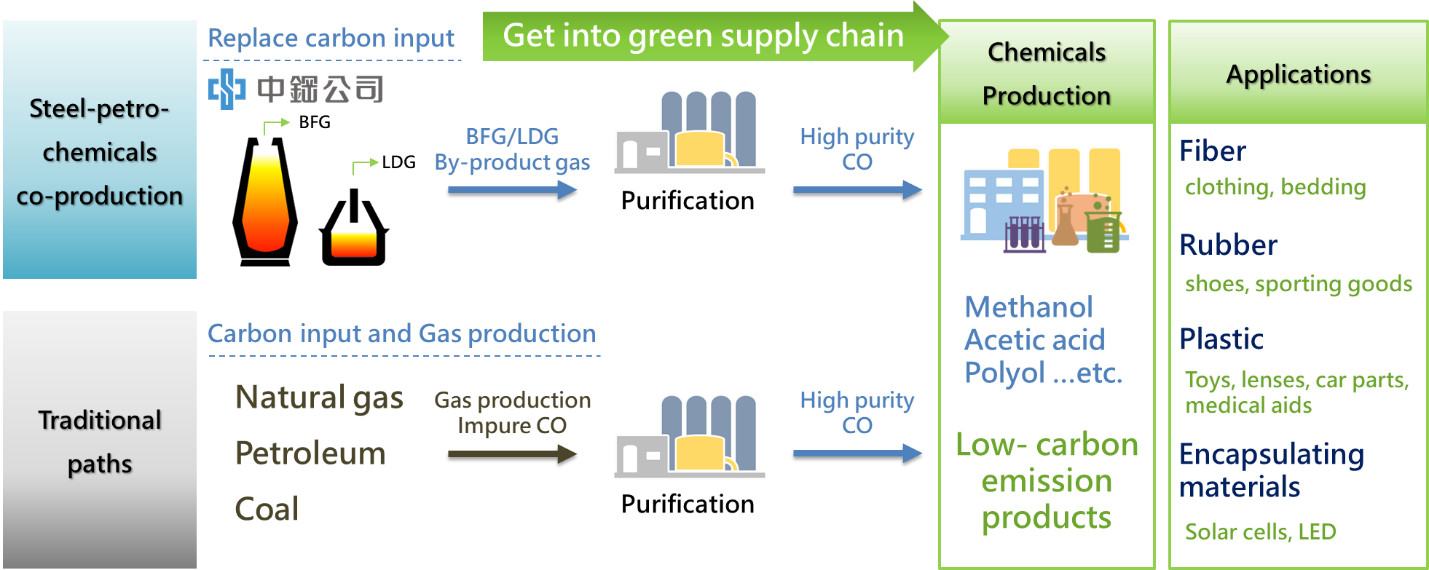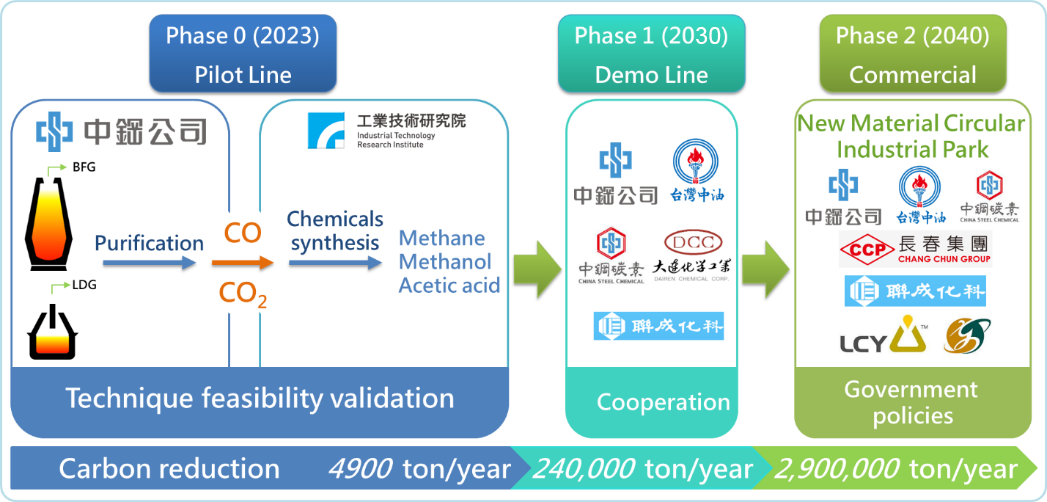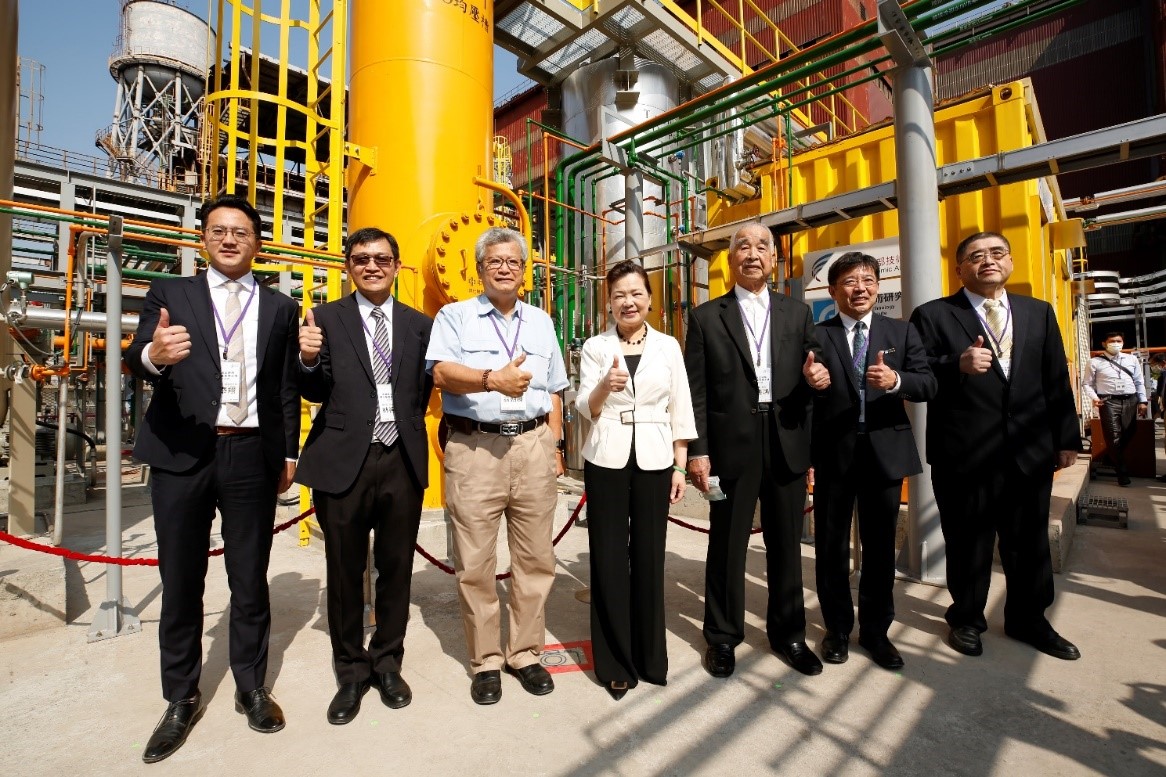Circular Economy
Promotion of “Co-production of Steel and Petrochemicals” to Reduce Carbon Emissions
Carbon neutrality is an issue of great concern around the world. In order to improve the sustainable development of ESG and pursue environmental management and clean production, CSC established the Task Force on Energy Saving, Carbon Reduction, and Carbon Neutrality in February 2021. Short-, medium-, and long-term goals to reduce carbon emissions have been set. To achieve carbon neutrality in 2050, a carbon neutral pathway has been planned, and strategies to reduce carbon emissions have been established. CSC hopes to create a society with sustainable development, lead various industries with action, and help the government to achieve the goal of carbon neutrality.
In terms of reducing carbon emissions, co-production of steel and petrochemicals is an effective strategy that integrates the resources of the two major industries. With the cross-industry cooperation model, the raw material costs of the petrochemical industry can be reduced, which not only helps the steel and petrochemical industries to significantly reduce carbon emissions but also expands the scope of CSC's energy resource integration in the area. In response to carbon neutrality, it is also the best example of practicing circular economy.

High-value Reutilization of Carbon Resources
By-product gases produced from steelmaking processes at CSC, such as blast furnace gas (BFG) and LD-converter gas (LDG), are rich in carbon monoxide (CO) and carbon dioxide (CO2). In the past, by-product gases were primarily supplied to heating furnaces at mills for heating and boilers at power plants for gas-fired power generation. The co-production of steel and petrochemicals” is a new cross-industry collaboration model. CO is one of the raw materials used for synthesizing chemicals in the petrochemical industry, while CO2 is the key to reduce carbon emissions by using carbon capture and utilization techniques (CCU). In the future, CO and CO2 extracted from the by-product gases provided by CSC can replace raw materials for chemicals that have to be imported by the petrochemical industry from abroad and be used to synthesize chemicals, such as methane, methanol, and acetic acid with various processes in the petrochemical industry. By fixing carbon into chemicals, carbon emissions can be reduced in both industries. Moreover, a new industry chain can be created in low carbon circular economy.
CSC has long utilized steam produced from combined heat and power (CHP) and waste heat recovery as well as industrial gases produced from the oxygen plant to share excess energy with neighboring petrochemical and steel plants in the Kaohsiung LinHai Industrial Park. With the complementary uses of steam, oxygen, nitrogen, argon, plant air, coke oven gas, etc., energy and resources in the district are efficiently integrated. In 2021, CSC started the “Co-production of Steel and Petrochemicals” plan. By combining the research and development experiences of the industry and academia, CSC expected to achieve carbon neutrality and create a new low-carbon circular economy industry chain. With the introduction of “Co-production of Steel and Petrochemicals” as a new cross-industry collaboration model born out of previously established district energy integration and cooperation between CSC and petrochemical industry players in the Linhai Industrial Park, both parties can not only share and exchange excess energy sources, such as steam, nitrogen, and hydrogen, with each other but also expand the supply of carbon resources, such as CO and CO2

The Three Phases of Carbon Reduction in the “Co-production of Steel and Petrochemicals”
The “Co-production of Steel and Petrochemicals” plan launched by CSC and the petrochemical industry can be divided into three phases. In Phase 0, CSC provided laboratory facilities and established a pilot plant to validate the feasibility of carbon capture from by-product gases, and then developed the auxiliary operation and production technology corresponding to the expansion of the “Co-production of Steel and Petrochemicals” strategy in the future. CSC collaborated with the Industrial Technology Research Institute (ITRI) to develop and validate the high-value carbon utilization technology which was funded by the National Forward-looking Infrastructure Program. In Phase 1, with the operation experiences of Phase 0, CSC will aspire to establish a demonstration production line by cooperating with petrochemical industry partners. The demonstration production line will be more energy-efficient, emit less carbon, and have lower production costs. Phase 2 will be the expansion of commercial applications. With the experiences gained from the first two phases and in line with the national policy of setting up a “New Material Recycling Industrial Park,” the plan is to expand the commercial application in order to maximize carbon reduction, build a low-carbon product industry chain with the petrochemical industry, and reduce carbon emissions in Taiwan.

The status of the “Co-production of Steel and Petrochemicals”
Both CSC and CPC Corporation signed a memorandum of understanding on August 27, 2021 with the construction of an R&D platform serving as the prelude to the initiation of cooperation between both parties. CSC was also in talks with other petrochemical companies, such as the Chang Chun Group, Dairen Chemical Corporation, CSCC, and UPC Technology Corporation, over potential cooperation in the launch of the “Co-production of Steel and Petrochemicals.” CSC has seized new business opportunities from carbon reduction through collaboration between both the steel and petrochemical industries and progressed towards Carbon neutrality together, thereby contributing to environmental protection while generating benefits simultaneously and turning the carbon reduction crisis into a turning point and a business opportunity. The pilot plant for co-production between steel and petrochemical plants was completed in September 2022. CSC collaborated with the ITRI in conducting on-site verification of by-product gas carbon capture and high-value technologies.
CSC hopes to build up the operation and maintenance technology and accumulate practical experiences in the pilot plant so that the second phase of the project to co-produce steel and petrochemicals can be promoted smoothly. CSC uses pressure swing adsorption technology to capture CO in the by-product gas of the metallurgical process, completed verification of 1,000-hour continuous production of the pilot plant for co-production between steel and petrochemical plants in 2023. The quality and production capacity of CO product gas are both stable. Using the ITRI's catalytic conversion technology, methanol is produced from CO with a methanol selectivity of 99.9%, verifying the technical feasibility of synthetic chemicals. The quality of CO product gas can meet the raw material needs of downstream petrochemical companies. CSC also developed energy-saving operation technology for carbon capture from by-product gas, which reduces compressor energy consumption by 10% under the same production capacity and reduces production costs.

